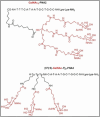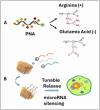Recent Cutting-Edge Technologies for the Delivery of Peptide Nucleic Acid
- PMID: 40351137
- PMCID: PMC12172603
- DOI: 10.1002/chem.202500469
Recent Cutting-Edge Technologies for the Delivery of Peptide Nucleic Acid
Abstract
Peptide nucleic acids (PNAs) have garnered significant attention due to their enhanced chemical, physical, and binding properties in comparison to natural nucleic acids. This prompted their application in antigene/antisense approach, assigning them a pivotal role in gene editing and, more recently, showing their potential as "bilingual" molecules being able "to speak" both nucleic acid and protein language. However, to expand the applications of PNAs in therapy, the challenge of effectively delivering PNAs to cells needs to be addressed. Among several delivery approaches employed so far, the nanotechnology-based ones showed great potential. In this review, we provide an overview of the latest in the field (2019 to present), beginning from peptide-based delivery systems, as well as cutting-edge approaches involving nanoparticles, liposomes, and calixarene, showing how they have inspired the development of smarter delivery approaches to boost PNAs applications.
Keywords: calixarene; delivery systems; liposomes; nanoparticles; peptides.
© 2025 The Author(s). Chemistry – A European Journal published by Wiley‐VCH GmbH.
Conflict of interest statement
The authors declare no conflict of interest.
Figures
















References
-
- Nielsen P. E., Egholm M., Berg R. H., Buchardt O., Science 1991, 254, 1497. - PubMed
-
- Egholm M., Buchardt O., Christensen L., Behrens C., Freier S. M., Driver D. A., Berg R. H., Kim S. K., Norden B., Nielsen P. E., Nature 1993, 365, 566. - PubMed
-
- Uhlmann E., Peyman A., Breipohl G., Will D. W., Angew. Chem. Int. Ed. 1998, 37, 2796. - PubMed
-
- Ratilainen T., Holmén A., Tuite E., Nielsen P. E., Nordén B., Biochemistry 2000, 39, 7781. - PubMed
-
- Muangkaew P., Vilaivan T., Bioorg. Med. Chem. Lett. 2020, 30, 127064. - PubMed
Publication types
MeSH terms
Substances
Grants and funding
LinkOut - more resources
Full Text Sources

